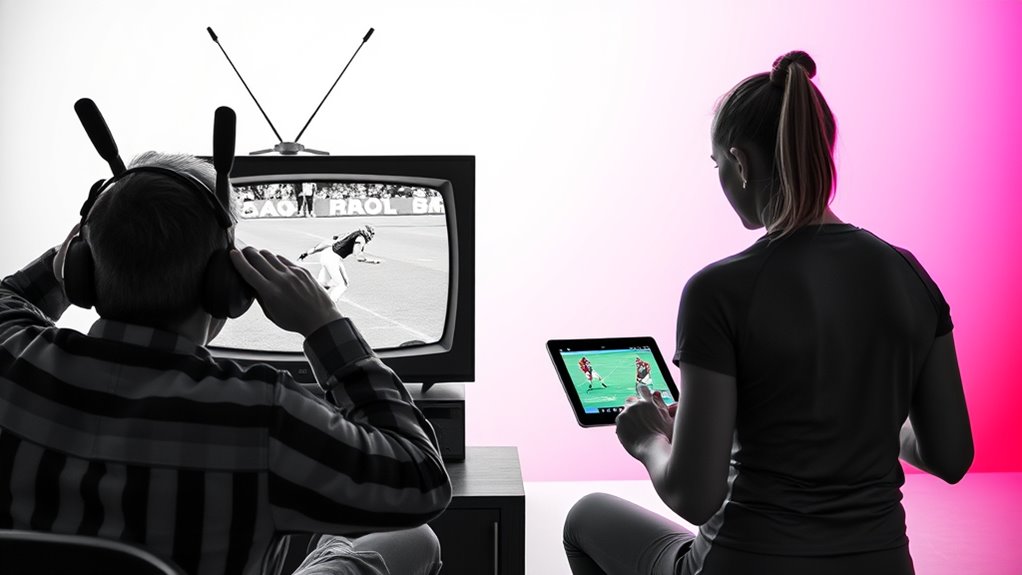The development of sports broadcasting has come a long way, from black-and-white TV screens to high-definition streaming platforms that bring games to your devices anytime, anywhere. Innovations like virtual reality now let you experience games as if you’re right there courtside, while social and interactive features boost your engagement. Home theater tech and multiple camera options make watching more immersive and personalized. Keep exploring to discover how these advancements are shaping the future of sports viewing.
Key Takeaways
- Transition from black-and-white television to color broadcasting enhanced visual appeal and viewer experience.
- Introduction of cable, satellite, and then streaming platforms expanded access and real-time coverage globally.
- Advancements in camera technology enabled multiple angles, high-definition, and immersive virtual reality viewing.
- Streaming platforms offered on-demand access, interactive features, and social integration, transforming sports consumption.
- Modern broadcasting combines VR, high-quality streaming, and social media to create immersive, personalized, and engaging sports experiences.

The development of sports broadcasting has transformed how fans experience athletic events, making it possible to watch live games from virtually anywhere. Thanks to technological advancements, you’re no longer limited to just listening on the radio or viewing on a small television screen. Instead, you can now immerse yourself in the action through innovative formats like virtual reality, which offers a truly immersive experience. With VR headsets, you feel as if you’re sitting courtside or right behind home plate, providing a perspective that traditional broadcasts can’t match. This leap in technology not only heightens your enjoyment but also deepens your connection to the game.
Virtual reality has become a game-changer for audience engagement, allowing you to interact with the broadcast in ways that were once unimaginable. Instead of passively watching, you can choose different camera angles, explore 360-degree views, or even walk around virtual stadiums. This level of control makes you an active participant, heightening your emotional investment. Sports broadcasters leverage VR to create personalized viewing experiences, making each game feel unique to you. As a result, you’re not just a viewer but a part of the event, which profoundly boosts your engagement and emotional connection with the sport.
The rise of streaming platforms has further revolutionized sports broadcasting, making high-quality, real-time coverage accessible on your preferred devices—smartphones, tablets, laptops, or smart TVs. Streaming services often provide options for multiple camera angles, commentary choices, and interactive features, giving you more control over how you watch. This flexibility means you can tune in whenever and wherever you want, whether you’re at home, commuting, or traveling. Additionally, live streaming allows for instant sharing of highlights and instant replays, so you stay up-to-date with the latest moments and can discuss them with friends or fellow fans online.
These technological innovations also foster a sense of community among viewers. Through social media integrations and live chat features, you can share your thoughts, celebrate big plays, or vent frustration in real time, creating a more connected and social viewing experience. When combined with virtual reality, streaming transforms the solitary act of watching into an interactive event that bridges distances and brings fans closer together. As technology continues to evolve, your experience as a sports fan will only become more immersive, personalized, and engaging, ensuring that the thrill of the game stays alive no matter where you are.
Furthermore, the development of home theatre projectors has enhanced the overall viewing experience by providing large, theater-like screens at home, allowing fans to enjoy games in stunning clarity and detail.
Frequently Asked Questions
How Did Early Sports Broadcasts Influence Fan Engagement?
Early sports broadcasts greatly boosted fan engagement by introducing broadcast innovation that brought games into homes. You could experience live action, feel connected to players, and share moments with others. This increased fan interaction created excitement and loyalty, making sports more accessible and personal. These innovations set the stage for modern broadcasts, encouraging fans to stay engaged and passionate about their favorite teams and athletes.
What Technological Challenges Delayed Sports Broadcasting Advancements?
You may not realize it, but technical hurdles like cable limitations and signal transmission issues slowed sports broadcasting progress. These challenges caused interruptions and poor picture quality, frustrating viewers and delaying innovations. For years, broadcasters struggled to deliver seamless, high-quality live coverage, holding back fan engagement and the industry’s growth. Overcoming these obstacles required advances in transmission technology, paving the way for the dynamic, accessible sports broadcasts you enjoy today.
How Have Regional Restrictions Impacted Sports Streaming Accessibility?
Regional restrictions, like geo-blocking policies and regional licensing, limit your access to sports streaming content based on your location. These policies often prevent you from watching certain games or channels outside specific regions, creating frustration. Broadcasters enforce these restrictions to protect regional rights and revenue, but they also restrict your ability to enjoy live sports seamlessly. As a result, you may need VPNs or alternative services to bypass these barriers.
What Role Did Advertising Play in the Evolution of Sports Media?
Advertising played a vital role in sports media evolution by fueling growth through sports sponsorships and advertising revenue. You see, sponsors invested heavily to promote their brands during broadcasts, increasing revenue for leagues and broadcasters. This financial boost allowed for better production quality, expanded coverage, and the rise of televised sports. As a result, advertising became a key driver, transforming sports media into a lucrative industry that attracts global audiences.
How Do Emerging Technologies Like AI Shape Future Sports Broadcasts?
AI integration transforms your sports viewing experience by enabling immersive viewing like never before. While traditional broadcasts show just the game, emerging technologies offer real-time stats, personalized angles, and instant highlights, creating a dynamic connection. You’ll see more engaging content, tailored to your preferences, blending the virtual with reality. This fusion of AI and immersive viewing shapes the future, making every game more interactive, exciting, and customized for you.
Conclusion
You’ve seen how sports broadcasting has evolved from black-and-white TVs to instant streaming. Imagine a theory suggesting that today’s rapid tech advancements are shaping a future where live sports are accessible anywhere, anytime, and in immersive formats. While it’s a bold idea, it’s quite believable considering how quickly technology progresses. So, stay excited — the next chapter might bring even more incredible ways to experience sports, all at your fingertips.









